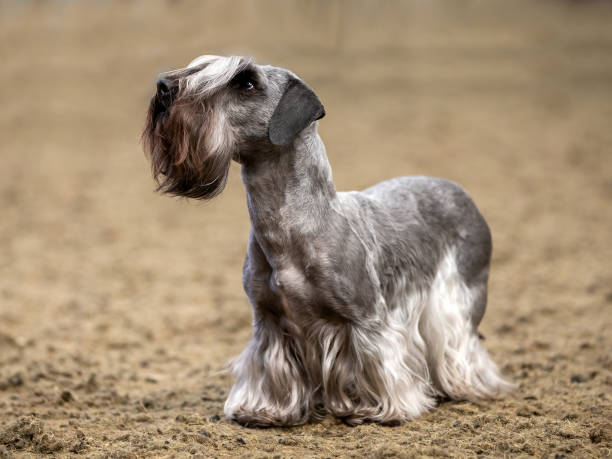Cesky Terrier

Breed History:
The Cesky Terrier (pronounced chess-kee) is a relatively young breed developed in Czechoslovakia in the 1940s by geneticist and dog breeder František Horák. His goal was to create a terrier suitable for hunting in dense forests and burrows while being more mellow and family-friendly than traditional terriers.
Horák achieved this by crossing the Sealyham Terrier with the Scottish Terrier, selectively breeding for a longer body, softer coat, and gentler temperament. The Cesky was officially recognised in Czechoslovakia in 1963 and by the Fédération Cynologique Internationale (FCI) in 1963. The American Kennel Club (AKC) accepted it into the Terrier Group in 2011.
|
Gender |
Height |
Weight |
|
Male |
27-32 cm |
7-10 kg |
|
Female |
25-30 cm |
6-9 kg |
Size – Small to Medium
Life Expectancy: 12–15 years

Breed Appearance:
The Cesky Terrier is a short-legged, long-bodied terrier with a distinctive silky, wavy coat and a well-muscled, sturdy build. Its head is long and narrow, with a prominent beard, mustache, and eyebrows, giving it a dignified yet charming look.
The coat comes in shades of gray (from platinum to charcoal) or, less commonly, coffee brown. Puppies are born black or brown and lighten as they mature. The body is rectangular, with a strong back and a tail that is either natural or slightly curved. Ears are triangular and drop forward, and eyes are dark and expressive.
Breed Type – Companion/Working Terrier:
Bred for hunting and companionship, the Cesky Terrier is more laid-back and adaptable than most terriers. It retains its tenacity underground but is also affectionate, calm, and loyal, making it an excellent family dog.
Ceskys are generally friendly with children and other dogs, especially when socialized early. They are alert but not overly yappy, and they form close bonds with their people. While they have a hunting background, they are more reserved and easier to manage in the home than many terriers.

Training:
The Cesky Terrier is intelligent, eager to please, and responsive to positive reinforcement. It learns commands quickly but may need variety to stay engaged. Unlike many terriers, it is not excessively stubborn and does well with gentle, consistent training.
Early socialization helps prevent shyness or wariness with strangers. Cesky Terriers enjoy basic obedience, agility, and tracking games, making them well-suited to both casual and competitive dog activities.
Health & Care:
The Cesky Terrier is generally a robust and healthy breed, but some health concerns include:
-
Scottie Cramp – a minor movement disorder seen in terrier breeds
-
Patellar luxation
-
Progressive retinal atrophy (PRA)
-
Cardiac issues, though rare
-
Primary lens luxation (PLL)
Responsible breeders screen for these conditions. Regular vet checkups, vaccinations, parasite control, and a balanced diet contribute to a long, healthy life.

Living Conditions:
The Cesky Terrier is well-suited to apartment living or houses with yards. It is not hyperactive indoors, but it does need daily walks and playtime. It’s a people-oriented breed and doesn’t like to be left alone for long periods.
Ceskys are adaptable to urban or rural settings, and they tolerate both hot and cold climates, though their coats may need trimming in warmer weather. Secure fencing is important, as they retain a moderate prey drive.
Exercise:
Cesky Terriers need moderate daily exercise—typically 30–45 minutes of walks, play, or training. While less intense than other terriers, they still enjoy chasing, digging, or nose work activities that stimulate their natural instincts.
They love interactive toys, games of fetch, and puzzle feeders. Regular mental stimulation is key to preventing boredom-related behaviors.
Grooming:
The Cesky’s coat is soft, silky, and slightly wavy, requiring regular grooming. Unlike many terriers, its coat is clipped, not hand-stripped, which is easier for most owners to manage.
Grooming needs include:
-
Brushing 2–3 times per week to prevent tangles
-
Professional trimming every 6–8 weeks to maintain shape
-
Regular ear cleaning, nail trimming, and dental care
The breed is considered low-shedding and is often recommended for people with mild allergies.

Advantages:
-
Calm and affectionate, ideal for families
-
Easier to train than most terriers
-
Adaptable to apartments and city living
-
Low-shedding, silky coat
-
Friendly with other pets and children
-
Good watchdog without excessive barking
Disadvantages:
-
Requires regular professional grooming
-
May be reserved with strangers if not socialized
-
Can be stubborn if bored or under-stimulated
-
Still has a moderate prey drive—may chase small animals
-
Not widely available outside of Europe and North America

